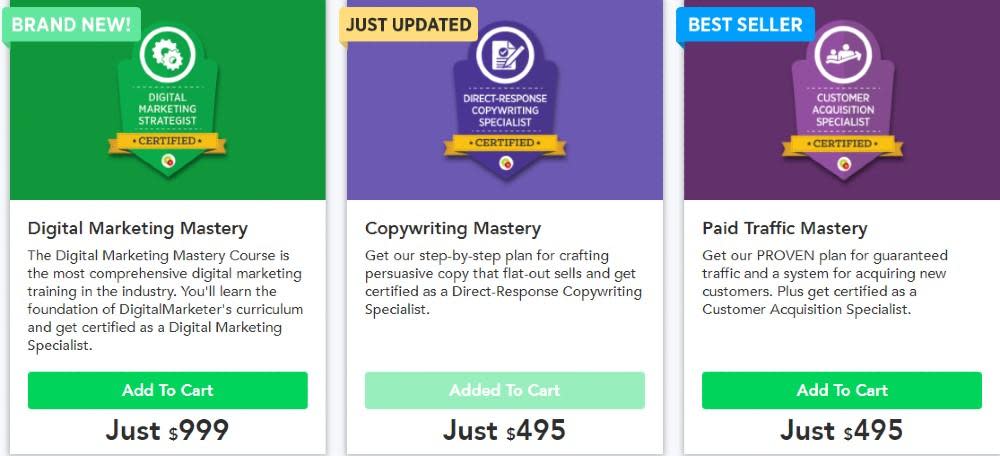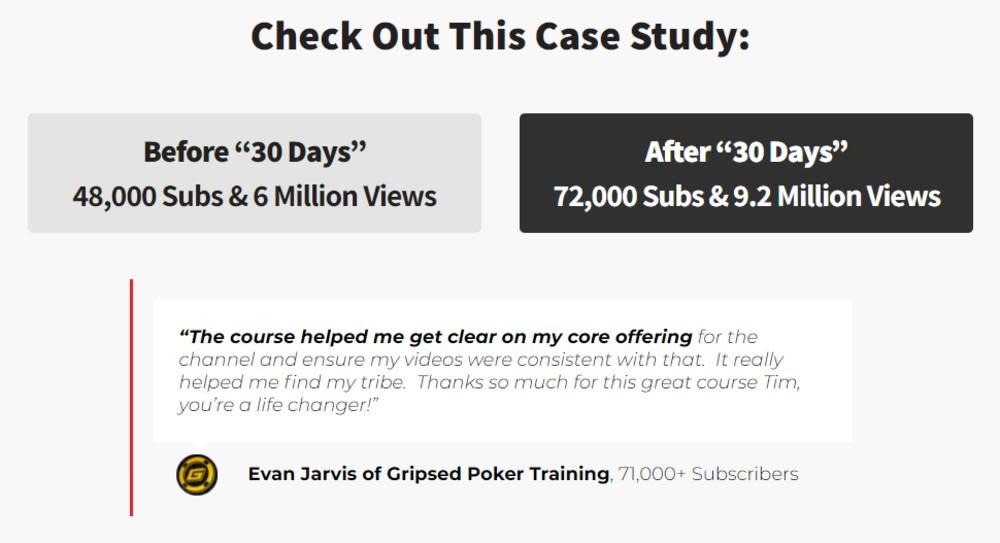With hundreds of online courses covering similar topics, you need to be sure yours stands out from the pack. One way to do that: social proof. Instead of trying to convince potential students that yours is the best course to take on the topic, have other people do the convincing.
As the founder of Sell Courses Online, I've helped thousands of people market their courses, and social proof has proven to be a big part of that. Here, I'll walk you through some ideas for social proof and offer tips for how to make the most of them.
1. Use an expert's voice to build credibility
Student reviews are great for your course—there's no doubt about that. But an expert can give you the extra boost of credibility you need to stand out. Think about it: wouldn't you be more likely to take a cooking course that's been "approved" by a respected chef?
If you've had experts or influencers enroll in your course, great; just ask them for a testimonial. That's what Andre Chaperon does for his course, Autoresponder Madness. You'll see several reviews from some of the best experts in the field, like Ryan Deiss and Jeff Walker, on his sales page. Their testimonials add credibility to Andre and his course.
But for most people, getting testimonials from niche influencers will be less straightforward. Here's what I suggest: start by creating a list of relevant experts. Once you have that list, think about why someone might want to leave a testimonial—what's in it for them? Here are a few angles you might mention:
You have a popular course. Share how many people are taking your course each month. Influencers will be more likely to leave a testimonial for a course with a large audience.
You have a robust promotion plan. Explain how you'll promote your course. For example, if you plan to feature the testimonial on your email list of 10,000 subscribers, that might get some attention.
You have a connection to the influencer. If you have a mutual business acquaintance or past experiences, you can leverage that. It's just like any other kind of networking.
Always send them a free login for your course (if it's not already free to anyone)—you want to show that you're looking for an authentic review, not just lip service.
And, of course, be realistic. If you're just starting out, the top influencers in your industry aren't likely to leave you a review. If that's the case, you might start with a list of micro-influencers instead: folks who are trying to work up their own credibility as well.
2. Use shareable badges and certificates
There's a reason doctors have their diplomas framed on their walls: it shows credibility. So if you can offer a certificate of completion, it can motivate people to take the class since they'll have a document to add to their portfolio. In other words, it makes it easier to prove they have the knowledge and skillset an employer might want.
And that means certificates are also a great form of social proof—people will show them off on LinkedIn and elsewhere, and other people will take that as a seal of approval.

That's why DigitalMarketer makes sure every course comes with a unique certificate and badge, and why they mention the certification in every course description.

Over time, the certification acquires more and more value—not to mention the increased exposure you'll get.
3. Include relevant case studies
Your students are taking courses for a reason. Maybe they're taking your Pinterest marketing class to increase referral traffic. Or maybe they're using your video editing course to grow their YouTube channel.
As a course creator, you should show people how your product has helped others achieve their specific goals. Creating relevant case studies for your course is pretty straightforward, as long as you set up the processes to gather information ahead of time.
Ask students to share their goals when they sign up for the course.
Ask students to provide feedback about the course upon completion, specifically asking them about how it helped them reach their goals.
Follow up with any compelling stories to see if you can feature them.
As a bonus, all this information will give you valuable feedback on how you might improve, so you can sell and profit from your online courses even more.
Take a look at this case study summary published on the Video Creators course page:

Here you see a YouTuber whose subscribers and views increased by roughly 50% in just 30 days. The numbers are compelling, and the personal testimonial from the student is the icing on the cake. That case study is a key part of the marketing material used on the site to help generate conversions.
4. Promote student reviews
Your course homepage should feature a sample of some of the best reviews from your students. Here are some specific tips for how to make the reviews as authentic and valuable as possible:
The student's name should always accompany the testimonial for authenticity.
If you can get permission, link to the student's LinkedIn page or website so people can see what kinds of professionals are taking the course.
Ask the best reviewers if they'd be willing to do a video testimonial—they add authenticity and can be repurposed on various platforms.
Here's a solid example from a Drone Launch Academy course.

Now, if you enable public student reviews, five stars aren't the only thing you'll be getting: some negative reviews are bound to appear. But a few three-star reviews aren't as bad as you think. Sure, they'll hurt your average rating, but nothing is as questionable as a wall full of nothing but endless five stars.
Don't delete the few negative reviews you may receive. Besides boosting the integrity of your rating system, they also give you a learning opportunity. Plus, how you respond to and handle the negative comments can show potential customers that you care about your students.
5. Highlight popular courses
Platforms that offer multiple courses should always highlight the most popular ones. Highlighting popular classes gives undecided students a starting point for their research and helps people find the best course in a given category.
For instance, a platform with dozens of SEO-related courses can be overwhelming to navigate. Potential students might not understand the fine details of SEO, meaning they have limited knowledge of what a good SEO course looks like. By pinpointing the most popular options—either by rating or number of students taking the course—you'll simplify the choice for them. Here's what that looks like on popular course platform Udemy.

Not only do they display the most popular courses, but they also provide the rating and number of reviews for each course. In doing so, they save interested learners lots of time and effort in finding the best option.
6. Leverage FOMO
Marketers love to leverage the fear of missing out to boost conversions.
eCommerce sites are a great example: you've probably seen notifications like "Only 4 items remaining!" or "Two other people are viewing this product" or "Someone bought this 3 days ago." That's a social proof tactic meant to create urgency and speed up the conversion process.
Let's look at the Drone Launch Academy example again. They use live social proof on the sales page to display recent course enrollments. You can use a social proof automation tool like Proof to automate this process.

You might also add a notification like "Only 10 seats remaining!" near the enrollment button or provide a time-limited discount with a conspicuous timer right next to it.
This was a guest post from Baidhurya Mani, the founder of SellCoursesOnline.com. To learn more about how you can create and sell online courses, check out his free guide. Want to see your work on the Zapier blog? Read our guidelines, and get in touch.





